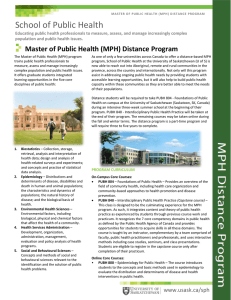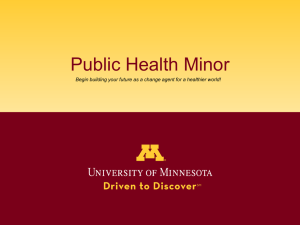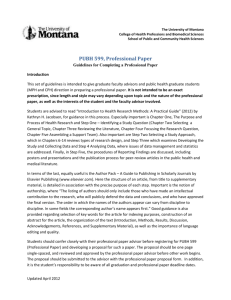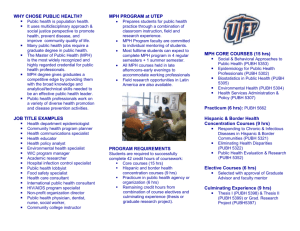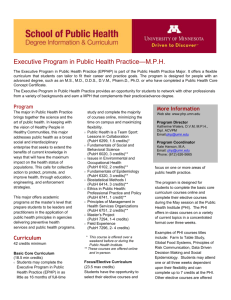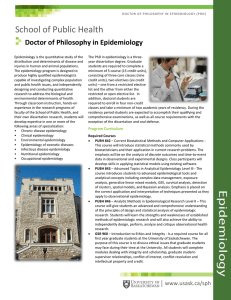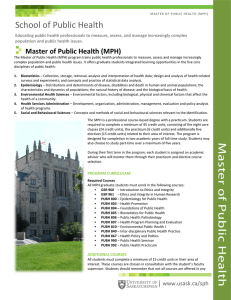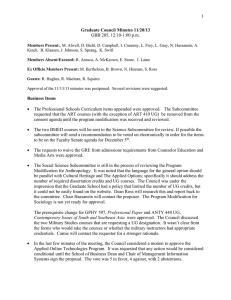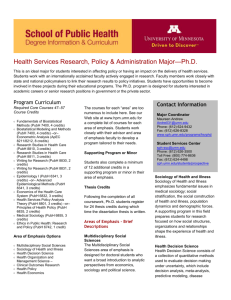Academic Programs Committee of Council Course Challenge June 10, 2010
advertisement
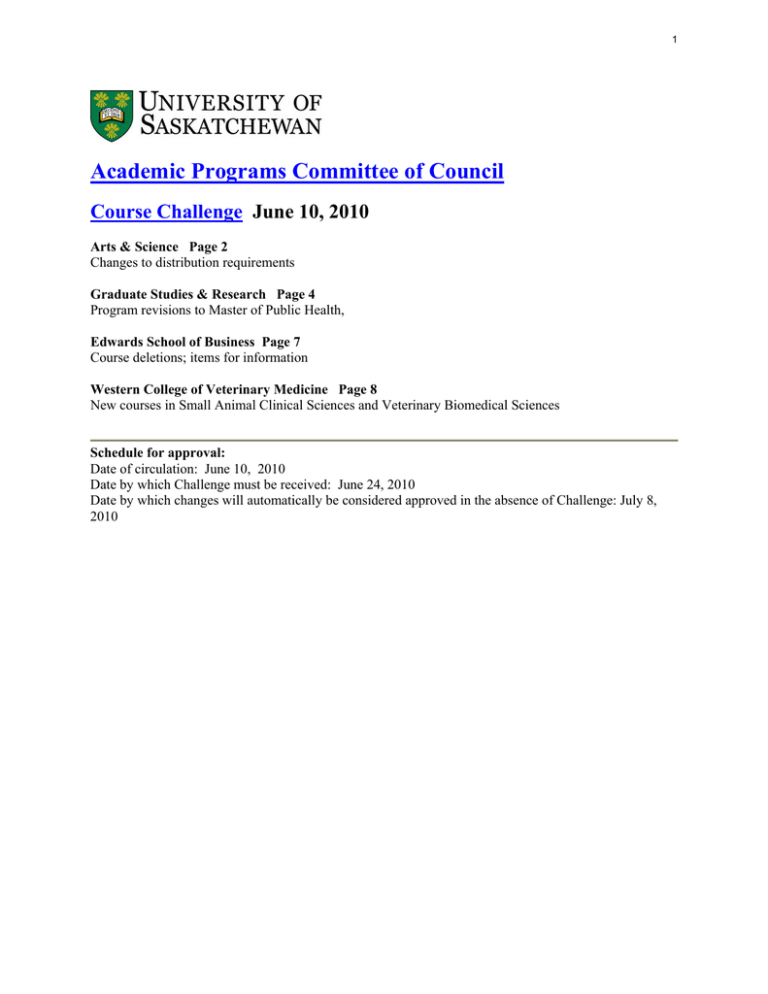
1 Academic Programs Committee of Council Course Challenge June 10, 2010 Arts & Science Page 2 Changes to distribution requirements Graduate Studies & Research Page 4 Program revisions to Master of Public Health, Edwards School of Business Page 7 Course deletions; items for information Western College of Veterinary Medicine Page 8 New courses in Small Animal Clinical Sciences and Veterinary Biomedical Sciences Schedule for approval: Date of circulation: June 10, 2010 Date by which Challenge must be received: June 24, 2010 Date by which changes will automatically be considered approved in the absence of Challenge: July 8, 2010 2 COLLEGE OF ARTS & SCIENCE The revisions listed below were approved through the Arts & Science College Course and Program Challenges and are now submitted for information or approval by University Course Challenge Change to Courses eligible to be used in Distribution Requirements (Sections with changes are listed; sections with no change are omitted.) B.A. & B.Sc. Degree Requirements Before a B.A. or B.Sc. degree can be awarded, the College requires the student to complete specific courses and meet certain regulations. Information on specific program requirements is available in the Programs section of the Calendar. Program majors in different areas of study are assigned a program “type”. The following types are defined for B.A. and B.Sc. degrees: Type A: Humanities (B.A.) Type B: Social Sciences (B.A.) Type C: Natural Sciences (B.Sc.) Type D: Fine Arts (B.A.) Humanities Only the following courses meet the Humanities Requirement in Programs A, B, D, or the General Requirement in Program C: CHIN 111.6, 130.6; CLAS 110.3, 111.3, 121.6; CREE 101.6, 120.6; ENG 110.6, 111.3, 112.3, 113.3, 114.3; FREN 103.3, 106.3, 122.3, 125.3, 128.3, 218.3; GERM 114.3, 117.3; GRK 112.3, 113.3; HEB 111.6; HIST 110.3, 111.3, 114.6, 120.6, 121.3, 122.3, 140.6, 148.6, 150.6, 151.3, 152.3, 170.6; INTS 101.12; LATN 112.3, 113.3; LIT 100.6; PHIL 110.6, 120.3, 133.3, 140.3; RLST 110.6; RUSS 114.3, 117.3; SNSK 101.6; SPAN 114.3, 117.3; UKR 114.3, 117.3; WGST 110.6, 112.3 or any senior-level humanities course provided that not more than 6 credit units in one subject are used for the Humanities or Languages Requirements. Certain WGST course may be considered a Humanities and/or Social Science. Refer to the course descriptions. CLAS 103.3, 104.3, 105.3 and 106.3 may not be used to fulfill the Humanities Requirement. Humanities Writing Requirement Program C Only the following courses meet the Humanities Writing Requirement in Program C: ENG 110.6, 111.3, 112.3, 113.3, 114.3; HIST 110.3, 111.3, 114.6, 120.6, 121.3, 122.3, 140.6, 148.6, 150.6, 151.3, 152.3, 170.6; INTS 101.12; LIT 100.6; PHIL 120.3, 133.3. Social Sciences Only the following courses meet the Social Science Requirement in Programs A, B, C, and D: ANTH 111.3; ARCH 112.3, 116.3; ECON 111.3, 114.3; GEOG* 130.3; LING 111.3, 112.3; NS 105.3, 106.3, 107.3; POLS 111.3, 112.3; PSY 110.6; SOC 111.3, 112.3 (SOC 111.3 and 112.3 were formerly SOC 110.6); WGST 110.6, 112.3 or any senior-level social science course provided that not more than 6 credit units in one subject are used for the Social Science Requirement. Statistics courses in social sciences are not accepted for credit toward the Social Science Requirement (eg. ECON 204.6, PSY 233.3 and 234.3, SOC 240.3). Certain WGST 3 courses may be considered a Humanities and/or Social Science. Refer to the course descriptions. PSY 101.3 and NRTH 101.3 may not be used to fulfill the Social Science Requirement. *No more than 6 credit units in Geography can be used in Distribution Requirements 1 to 5. Natural Sciences 1. The following courses meet the Natural Science Requirement in Programs A, B, and D: ASTR 102.3, 103.3; BIOL 107.6, 120.3, 121.3 (120.3 & 121.3 were formerly BIOL 110.6); CHEM 112.3, 115.3; CMPT 100.3, 102.3, 105.3, 106.3, 111.3, 115.3; GEOG* 120.3, or 125.3; GEOL 108.3, 109.3, 121.3, 122.3; MATH 101.3, 104.3, 110.3, 112.3 or 116.3, 121.3, 125.3, 128.3; PHYS 115.3, 117.3 or 125.3, 127.3 or 128.3; STAT 103.3 or any senior-level natural science course provided that not more than 6 credit units in one subject are used for the Natural Science Requirement. Students may use only 6 credit units in mathematics and statistics toward the Natural Science Requirement. STAT 244.3 may not be used to meet the Natural Science Requirement in Program Types A, B or D. 2. Only the following courses meet the Natural Science Requirement in Program C: a. Computer Science - CMPT 106.3, 111.3, 115.3 b. Physics & Astronomy - ASTR 102.3, 103.3; PHYS 115.3, 117.3 or 125.3, 127.3 or 128.3 c. Chemistry - CHEM 112.3, 115.3, 250.3 d. Earth Science - GEOG* 120.3; GEOL 121.3, 122.3 e. Biological Science - BIOL 120.3 and 121.3 (formerly BIOL 110.6) *No more than 6 credit units in Geography can be used in Distribution Requirements 1 to 5. 3. Mathematics/Statistics Requirement Program C Only the following courses meet the Mathematics/Statistics Requirement in Program C: MATH 110.3, 112.3, 116.3, 125.3, 128.3, 264.3; STAT 245.3, 246.3; PLSC 314.3. Rationale: Courses have been created which fit in the categories (INTS 101.12, WGST 112.3, NS 107.3, and MATH 128.3), one course was renumbered (MATH 101.3 became MATH 104.3) and one course was accidently included in the Natural Science course list for Type C programs previously, which is now removed (ASTR 102.3). Students may now receive credit for GEOG 120 and 125, in any order (pending approval of changes posted in the May 14, 2010 UCC). BA.&Sc. Degree Requirements Science Distribution Requirements (18 credit units) 18 credit units Natural Sciences chosen from lists A, B, C, D, E, and F collectively, with at least 3 credit units from list F and at most 6 credit units from any one list. A. Computer Science – CMPT 111.3, 115.3 B. Physics and Astronomy – ASTR 101.6; PHYS 111.6, 121.6, 128.3 C. Chemistry – CHEM 112.3, 115.3, 250.3 D. Earth Science – GEOG 120.3; GEOL 121.3, 122.3 E. Biological Science – BIOL 120.3, 121.3 F. Mathematics/Statistics: MATH 110.3, 112.3, 116.3, 264.3; STAT 245.3, 246.3; PLSC 314.3; or other introductory statistics courses as outlined in http://www.usask.ca/calendar/arts&science/policies/statscourseregulations/ 4 Rationale: The only Statistics courses which may be used to meet the requirement are STAT 245.3, STAT 246.3 and PLSC 314.3. The link to the Statistics Course Regulations is unnecessary, as the same information will be found there as the courses listed in F. College of Graduate Studies & Research Master of Public Health 1. Program requirements: The total credit unit requirement for the MPH degree will be increased from 42 CU to 45 CU. This program change is being posted for approval through University Course Challenge because it will not alter the average duration of the program (20 months) nor will it affect the tuition costs or revenues for the program. Rationale: The Master of Public Health (MPH) program was established at the University of Saskatchewan on its approval by University Council in March 2006. Initially structured as an interdisciplinary program of the College of Graduate Studies and Research, the program was subsequently transferred to the new School of Public Health as one of its core academic programs in July 2007. It was designed to meet the MPH guidelines of the Public Health Agency of Canada (PHAC) and the U.S. accreditation body, the Council on Education for Public Health (CEPH). Enrolment in the program has grown from 7 students in 2006-07 to 75 in 2010-11, and is projected to reach 120 by 2012-13. The MPH Program Advisory Committee has made several changes to improve the program. These changes arise from the recommendations of: 1.) students through their course evaluations and exit interviews, 2.) faculty members who teach courses, advise students, and supervise field placements, 3.) employers who hire graduates of the program, and 4.) the accreditation body, CEPH. Forty-two CUs is the minimum credit unit requirement identified in both the PHAC and CEPH MPH program guidelines but is below the usual number of CUs in other Canadian MPH programs (Table 1). An increase in the credit unit requirement for the degree will permit the addition of two courses to the list of required courses, while retaining sufficient elective opportunity (15 CU) for each student to develop an area of expertise within the field of public health. 2. Required courses: Two current courses will be required rather than elective: Foundations of Public Health (PUBH 804.3) and Health Program Planning and Evaluation (PUBH 807.3). Rationale: The Foundations of Public Health course provides an introduction to the field of public health, its fundamental principles and current issues, and an orientation to Canada’s health care system. This course has been a well subscribed elective to date, however the MPH Program Advisory Committee feels that the content is essential for all students at the beginning of their program. The Health Program Planning and Evaluation course introduces students to the principles and methods of health program design, implementation and evaluation. Similarly, given the feedback from alumni and employers, the Committee believes that the knowledge and skills acquired in this course are fundamental to the practice of public health. 5 3. Items for information: The credit unit value of the Public Health Practicum (PUBH 992.9) has been reduced from 9 to 6, to reflect the usual value for such courses in other MPH programs. Course names have also been clarified. CURRENT COURSE REQUIREMENTS Required Courses (27 CU): Epidemiology I (PUBH 800.3) Biostatistics I (PUBH 805.3) Health Politics and Policy (PUBH 867.3) Health Promotion (PUBH 803.3) Introduction to Occupational and Environmental Health (AGMED 801.3) Interdisciplinary Public Health Practice (Capstone) (PUBH 840.3) Public Health Practicum (PUBH 992.9) Public Health Seminar (PUBH 990.0) Introduction to Ethics and Integrity (GSR 960.0) Elective Courses (15 CU) PROPOSED COURSE REQUIREMENTS Required Courses (30 CU): Epidemiology for Public Health (PUBH 800.3) Biostatistics for Public Health (PUBH 805.3) Health Politics and Policy (PUBH 867.3) Health Promotion (PUBH 803.3) Introduction to Occupational and Environmental Health (AGMED 801.3) Foundations of Public Health (PUBH 804.3) Health Program Planning and Evaluation (PUBH 807.3) Interdisciplinary Public Health Practice (Capstone) (PUBH 840.3) Public Health Practicum (PUBH 992.6) Public Health Seminar (PUBH 990.0) Introduction to Ethics and Integrity (GSR 960.0) Elective Courses (15 CU) New courses Two new courses focus on the core knowledge and skills required for public health practice rather than research, systematically employ examples and datasets from the field of public health, and illustrate the use of epidemiological and biostatistical evidence in the development of public policy. Epidemiology for Public Health (PUBH 800.3) Calendar description: The course will introduce students to the concepts and basic methods used in epidemiology to evaluate the distribution and determinants of disease and health interventions in public health. It is a core course for students in the Master of Public Health program, but open to other health science students. Rationale: Epidemiology is a core science in the field of public health. Graduate students in the Master of Public Health (MPH) program are required to take an introductory course in epidemiology as part of their degree requirements. To date, students in the MPH program have taken Epidemiology I (CHEP 800.3) to meet this requirement. However, the latter course is targeted to graduate students who wish to pursue research careers in health science, not to those who chose to pursue professional practice in public health. The present course has been designed to specifically meet the needs of graduate students in the School of Public Health. All examples will be drawn from the field of public health, students will have the opportunity to critically review epidemiological methods used in published public health literature, and will examine several topics unique to the field of public health: the role of epidemiology in public health practice, disease surveillance, and the use of epidemiology in informing public policy. It will be 6 offered on-campus with several technological enhancements, including Web CT/Blackboard modules, podcasts and video recordings. Biostatistics for Public Health (PUBH 805.3) Calendar description: This course is designed for students who wish to understand basic biostatistical methods and principles as they apply to public health data. The methods include descriptive statistics, confidence intervals and hypothesis testing, analysis of variance, nonparametric methods, multiple regression and logistic regression. The emphasis of the course is on applications of these methods to public health data, on correct interpretations of the resulting analyses as to be presented to both public health professionals and general lay audiences, and on the critical appraisal of these methods as used in the public health literature. The course also introduces the computer software program SPSS as it applies to the statistical topics discussed in the course. Rationale: Biostatistics is a core science in the field of public health. Graduate students in the Master of Public Health (MPH) program are required to take an introductory course in biostatistics as part of their degree requirements. To date, students in the MPH program have taken Biostatistics I (CHEP 805.3) to meet this requirement. However, the latter course is targeted to graduate students who wish to pursue research careers in health science, not to those who chose to pursue professional practice in public health. The present course has been designed to specifically meet the needs of graduate students in the School of Public Health: all examples will be drawn from the field of public health, students will have the opportunity to critically review statistical methods used in published public health literature, and will be required to design statistical methods for an public health evaluation project. Public Health Biology (PUBH 806.3) Calendar description: The course will introduce students to the biological and molecular basis of public health so they are able to incorporate this knowledge into their practice of public health. The course is intended for those students in the Master of Public Health program who do not have training in one of the health sciences. Rationale: Approximately 30% of students entering the Master of Public Health (MPH) program have a bachelor's degree in a discipline other than one of the health sciences. As a result, these students face a disadvantage in the study of subjects such as epidemiology, health promotion and disease prevention which require a basic understanding of relevant biology. This proposed course in public health biology will be required for those students without a health science background so as to enable their success in the program. Such a course is offered in the majority of MPH programs in North America for this same purpose. Undergraduate & Certificate Programs Office7 Phone: 306-966-4785 Fax: 306-966-5408 MEMORANDUM MEMO TO: MEMO FROM: Cathie Fornssler, Secretary Academic Programs Committee Alison Renny, Associate Dean Undergraduate Curriculum Committee Edwards School of Business DATE: May 14, 2010 RE: Request approval for changes in B.Comm. curriculum The Faculty of the Edwards School of Business is asking the Academic Programs Committee of Council….. 1. To approve the elimination of COMM 308.3 and COMM 337.3 from the elective list in the Operations Management Major. Both of these classes have restricted access to accounting major students only. Approved by: ‐ The Department of Finance and Management Science on January 29, 2010. ‐ Edwards School of Business Undergraduate Curriculum Committee on April 23, 2010 ‐ Edwards School of Business Faculty on May 13, 2010 2. For Information only: Two new Special Topics courses: COMM 498.3 – Special Topics – Field Investigation in Operations Management (attached course proposal and outline) Approved by: ‐ The Department of Finance and Management Science on January 29, 2010. ‐ Edwards School of Business Undergraduate Curriculum Committee on April 23, 2010 ‐ Edwards School of Business Faculty on May 13, 2010 COMM 498.3 – Special Topics – Strategic Human Resource Management (attached course proposal and outline) Approved by: ‐ The Department of Human Resources and Organizational Behaviour on April 6, 2010 ‐ Edwards School of Business Undergraduate Curriculum Committee on April 23, 2010 ‐ Edwards School of Business Faculty on May 13, 2010 Contact Person: A.E. Renny, Associate Dean Edwards School of Business Curriculum Committee Attachments 8 Western College of Veterinary Medicine Following are five courses to go through Course Challenge. These courses are third year electives that will be offered in the 2010-2011 academic year. Contact: Dr. Bruce Grahn, Associate Dean (Academic) Small Animal Clinical Sciences VSAC 454.1 – Companion Animal Ophthalmology Total Hours: Lecture 12 hrs Restrictions: Successful completion of Year 2 of the Doctor of Veterinary Medicine Program. Calendar Description: Enrichment Companion Animal Ophthalmology is a course aimed at providing a deeper understanding of ocular anatomy and physiology, as well as, diagnostics, pathophysiology, therapeutics, and management of ocular disease in the canine, feline, and exotic species. The student will take part in didactic lectures and interactive tutorials. Rationale For This Course: The objectives of this course are to provide the student with an understanding of companion animal (including: canine, feline, and exotic species) ocular anatomy and physiology, as well as, diagnostics, pathophysiology, therapeutics and management of ocular disease in these species. This course will expand upon material covered in the ophthalmology core course. The rationale behind this elective is that the core curriculum provides only a very limited overview of ocular disease in these species. Some students will wish to deepen their knowledge and understanding of ophthalmology in these species and this course will facilitate that. VSAC 455.1 – Equine Ophthalmology Total Hours: Lecture 8 hrs; Lab 4 hrs Restrictions: Successful completion of Year 2 of the Doctor of Veterinary Medicine Program. Calendar Description: Enrichment Equine Ophthalmology is aimed at providing a deeper understanding of ocular anatomy and physiology, as well as, diagnostics, pathophysiology, therapeutics, and management of equine ocular disease. The student will take part in didactic lectures, interactive tutorials and laboratories. Rationale For This Course: The objectives of this course are to provide the student with an indepth understanding of equine ocular anatomy and physiology, as well as, diagnostics pathophysiology, therapeutics and management of ocular disease in this species. This course will expand upon material covered in the core course. The rational behind this elective is that the core curriculum provides a limited overview of equine ocular disease. Some students will wish to deepen their knowledge and understanding of ophthalmology in this species and this course will facilitate that. VSAC 456.1 – Large Animal Medical Imaging Total Hours: Lecture 10-12 hrs; Lab 2 hrs Restrictions: Successful completion of Year 2 of the Doctor of Veterinary Medicine Program. Calendar Description: This course will provide a comprehensive review of large animal (primarily equine) medical imaging. It will cover the basic equipment, radiography, positioning, and interpretation of radiographic images. If time allows a brief overview of nuclear 9 scintigraphy, computed tomography , ultrasound and MRI may be provided. Prerequisite course: VSAC 362 Introduction to Medical Imaging. Anatomical review is recommended to gain maximum benefit from this course. Rationale For This Course: There is no other opportunity for students to learn advanced large animal image interpretation until handling specific cases in their 580 rotations. VSAC 457.1 – Small Animal Dermatology Total Hours: Seminar 8 hrs; Lab 2 hrs Restrictions: Successful completion of Year 2 of the Doctor of Veterinary Medicine Program. Calendar Description: This is a case-based seminar course intended to familiarize students with the work-up and treatment of patients with selected skin and ear diseases. More in-depth discussion of treatment options is offered than in the core curriculum. The laboratory presents some common dermatologic conditions and their associated laboratory specimens. Advance preparation of case material is required. Rationale For This Course: Skin and ear diseases top most list of the most common reasons that small animal patients are presented to veterinarians. Veterinary Biomedical Sciences VBMS 439.2 – Fish Diseases Total Hours: Lecture 20 hrs; Lab 4 hrs Restrictions: Successful completion of Year 2 of the Doctor of Veterinary Medicine Program. Calendar Description: This course introduces students to the many aspects of fish diseases. Students will get an overview on fish and its environment, as well as on fish pathogens and parasites, and environmental fish diseases. The course conforms to the academic requirements and standards for graduate courses, including the rules of Academic Honesty (see: http://www.usask.ca/honesty/) and Student Appeals in Academic Matters (see: http://www.usask.ca/university_council/reports/12-06-99.shtml). Rationale For This Course: In light of the fact that aquaculture is the fastest growing sector in global agriculture, as well as an increasing impact of anthropogenic activities on aquatic habitats, there is a need for qualified specialists in the area of fish diseases. So far there is no course available at the U of S that addresses fish health issues in detail. This course will fill this gap and aims at raising awareness and interest in this field. Information for Course Challenge: Beginning in the 2010-11 academic year VSAC 358.1 (Veterinary Dentistry) originally a second year course has moved to the third year program with the new course number VSAC 458.1.
